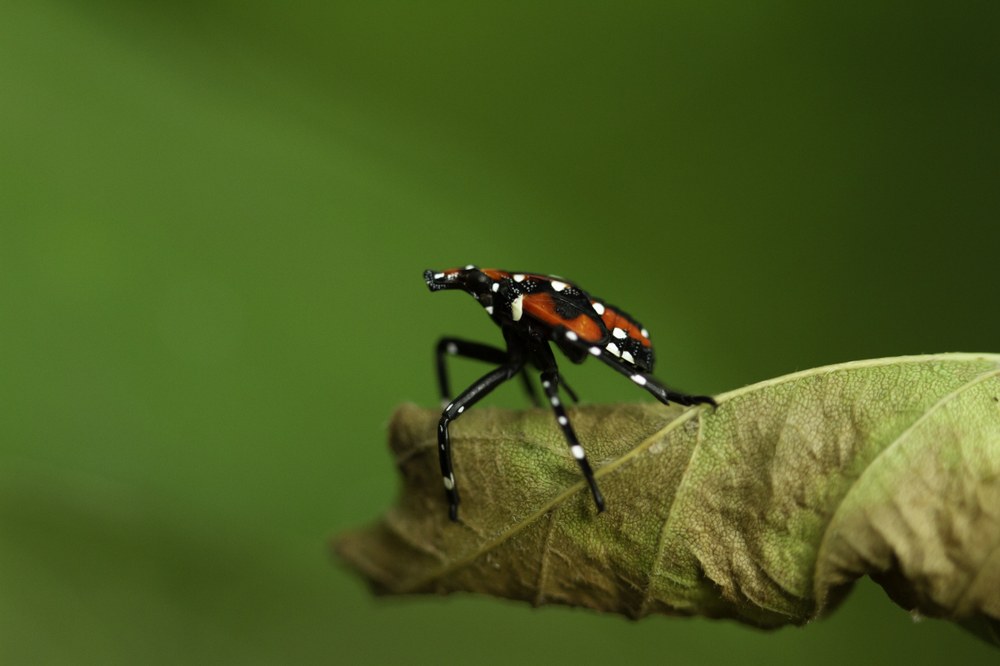Posted: March 17, 2021
The Penn State Extension of Berks County Master Gardeners feature questions and answers to inquires received through our Garden Hotline. Two recent questions and their answers are outlined.

Spotted Lanternfly late stage nymph. Photo credit: Jim Harding, Penn State University
Question: What are ephemerals?
Answer: The word ephemeral means quickly fading. Ephemerals are woodland perennials that bloom and produce seeds in early spring, then wither away and go dormant as if they were never there.
After a long winter, the first plants of spring emerge among leaf litter to expose their dainty flowers. Ephemerals live below the moist moss and bare deciduous trees, awakening as the warmth of the sun penetrates bare branches and warms the soil.
Native yellow trout lily (Erythronium americanum) has a sweet-scented yellow blossom. Small pink flowers can be found on Virginia Spring Beauty and hepatica (Hepatica acutiloba) with its stems covered with dense hair to protect them from frost. Trilliums have three colorful petals of white (Trillium grandiflorum), yellow (Trillium luteum) or red (Trillium erectum). Native bumblebees are essential for pollination of many spring ephemerals.
Question: When is the best time to prune flowering shrubs?
Answer: Pruning time depends on when they flower. Spring flowering shrubs are pruned soon after flowering. Examples are forsythia (Forsythia spp.), Virginia sweetspire (Itea virginica), mock orange (Philadelphus spp.), ninebark (Physocarpus opulifolius), quince (Chaenomeles spp.), rhododendrons, including azaleas (Rhododendron spp.), spring flowering roses (Rosa spp.), spring blooming spiraea (Spiraea prunifolia and S. x vanhoutter), lilacs (Syringa spp.) and viburnums (Viburnum spp.). These bloom on old wood.
Shrubs that bloom in summer and fall usually set their flower buds on the current season's growth (bloom on new wood) and can be pruned in late winter or early spring. Examples are sweetshrub (Calycanthus floridus), smooth hydrangea (Hydrangea arborescens), repeat blooming roses (Rosa spp. and hybrids).
Pruning is done to maintain the health and appearance of the shrub. Removing damaged, dead and diseased wood is important and may been done any time. Pruning encourages new growth of stems and new flowering wood for next year.
Question: What can I do right now in March related to Spotted Lanternfly on my property?
Answer: Walk around your property to check for egg masses on trees, cement blocks, rocks, and any other hard surface. If you find egg masses on your property, you can scrape them off using a plastic card or putty knife. Scrape them into a bag or container filled with rubbing alcohol or hand sanitizer and keep them in this solution permanently. Egg masses can also be smashed. Remember that some eggs will be unreachable at the tops of trees, in other well-hidden areas, and throughout your neighborhood and community. Be aware that this method may not reduce the number of nymph or adult SLF you see later in the year. Every effort to control this insect is worthwhile.
When you travel in and out of the quarantine zone, check your car and any outdoor items you are moving (grills, outdoor furniture, landscaping supplies, mowers, etc.). Remember that egg masses may be underneath your car or in your wheel wells. During all other times of the year, check for nymphs and adults, and keep your windows rolled up when you park. Don't store things or park under infested trees, and don't move firewood.
For more information and current up-dates visit the Penn State Spotted Lanternfly website
Penn State Master Gardeners with advanced diagnostic training staff the hotline, answering questions on lawn care, landscape plants, houseplants, fruit, vegetables and herbs, insect and disease issues, and identification of unknown plants or insects. Advice is based on Integrated Pest Management strategies and environmentally-friendly approaches. For more information on these and other gardening-related topics, email the Garden Hotline at berksmg@psu.edu

